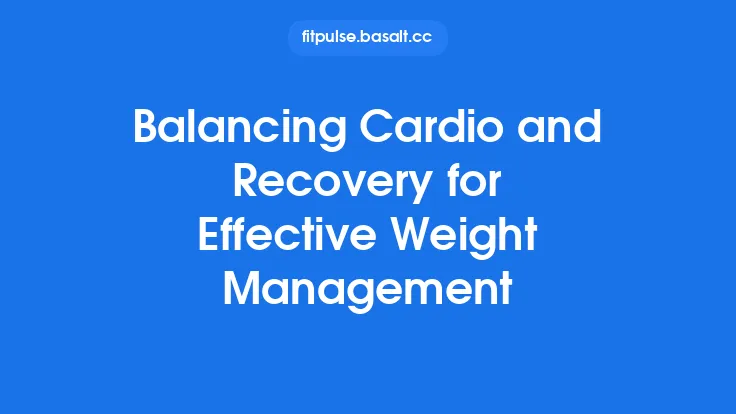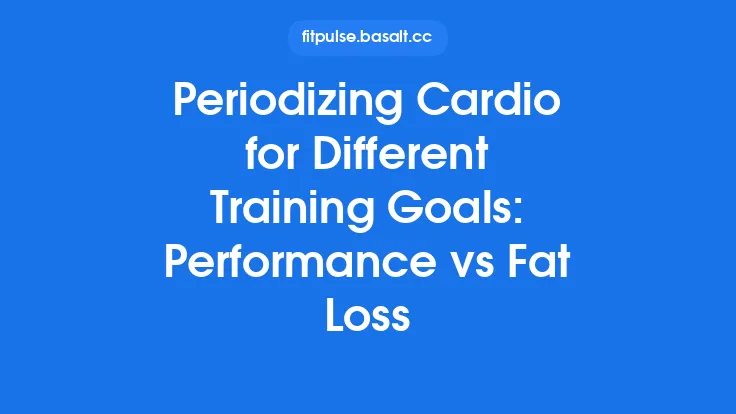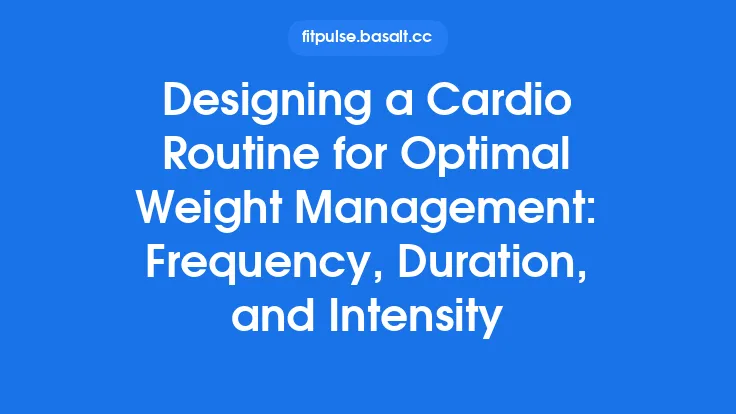Combining cardio with nutrition is the cornerstone of any sustainable weight‑loss plan. While cardio creates the caloric deficit needed to shed pounds, nutrition determines whether that loss comes from fat rather than muscle, how quickly you recover, and how well you can stick with the program over months and years. By treating these two pillars as a coordinated system rather than isolated tasks, you can achieve steady, lasting results without the roller‑coaster of yo‑yo dieting or burnout.
The Energy Balance Equation: How Cardio and Nutrition Interact
Weight loss ultimately follows the principle of energy balance: calories in vs. calories out. Cardio contributes to the “out” side by increasing total daily energy expenditure (TDEE), while nutrition controls the “in” side by dictating how many calories you consume.
- Resting Metabolic Rate (RMR) – The calories your body burns at rest. This accounts for roughly 60‑75 % of total daily expenditure for most adults.
- Thermic Effect of Food (TEF) – The energy required to digest, absorb, and store nutrients (≈10 % of intake).
- Non‑Exercise Activity Thermogenesis (NEAT) – The calories burned through everyday movements (fidgeting, walking to the kitchen, etc.).
- Exercise Activity Thermogenesis (EAT) – The calories burned during structured cardio sessions.
When you add cardio, you raise EAT, but the body may compensate by reducing NEAT or even RMR if the deficit is too large. Nutrition can mitigate this compensation by ensuring adequate protein and micronutrients, which help preserve RMR and support hormonal balance. The key is to create a moderate, sustainable deficit—typically 300‑500 kcal per day—so that the body does not trigger strong adaptive mechanisms that stall progress.
Understanding Metabolic Adaptations to Cardio Training
Repeated cardio sessions trigger several physiological adaptations that influence how your body uses fuel:
| Adaptation | Effect on Energy Use | Nutritional Implication |
|---|---|---|
| Increased mitochondrial density | Improves the ability to oxidize fats at lower intensities | Emphasize healthy fats to fuel prolonged, low‑intensity work |
| Enhanced glycogen storage capacity | Allows higher intensity bursts without early fatigue | Include moderate‑glycemic carbs before high‑intensity intervals |
| Improved insulin sensitivity | Facilitates glucose uptake into muscles, reducing blood sugar spikes | Balanced carb intake can maintain stable energy levels |
| Hormonal shifts (e.g., reduced leptin, increased ghrelin) | May increase appetite if deficit is too aggressive | Adequate protein and fiber help curb hunger signals |
Understanding these adaptations helps you fine‑tune your diet to match the evolving demands of your cardio regimen, preventing plateaus and preserving metabolic health.
Macronutrient Strategies to Support Cardio‑Driven Weight Loss
Protein: The Muscle‑Preserving Powerhouse
- Recommended intake: 1.2–2.0 g per kilogram of body weight per day, depending on training intensity.
- Why it matters: Protein provides the amino acids needed for muscle repair, curbs appetite via satiety hormones, and has a higher TEF (≈20‑30 % of calories) compared with carbs or fats.
- Practical tip: Distribute protein evenly across 3‑5 meals (≈20‑30 g per serving) to maximize muscle protein synthesis throughout the day.
Carbohydrates: Fuel for Performance
- Recommended intake: 3–5 g per kilogram of body weight for moderate cardio; 5–7 g/kg for high‑intensity or long‑duration sessions.
- Why it matters: Carbs replenish muscle glycogen, which is the primary fuel for cardio above ~60 % of VO₂max. Adequate glycogen prevents early fatigue and preserves protein for repair rather than energy.
- Practical tip: Choose complex, fiber‑rich sources (whole grains, legumes, fruits) for steady glucose release, and reserve simple carbs (e.g., a banana or a small sports drink) for pre‑ or intra‑workout use when intensity spikes.
Fats: The Endurance Ally
- Recommended intake: 0.8–1.0 g per kilogram of body weight, making up roughly 20‑30 % of total calories.
- Why it matters: Fat oxidation dominates during low‑intensity, long‑duration cardio, sparing glycogen for higher‑intensity bursts. Essential fatty acids (omega‑3s) also support inflammation control and cardiovascular health.
- Practical tip: Incorporate sources like fatty fish, nuts, seeds, and avocados, and avoid excessive saturated fats that can impair insulin sensitivity.
Timing Your Meals Around Cardio Sessions
Pre‑Workout (30‑90 minutes before):
- Aim for a small, carbohydrate‑focused snack (15‑30 g carbs) with a modest amount of protein (5‑10 g).
- Example: Greek yogurt with berries, a slice of whole‑grain toast with a thin spread of nut butter, or a banana with a handful of almonds.
- Purpose: Elevate blood glucose, provide readily available fuel, and prevent early‑exercise hypoglycemia.
During Prolonged Cardio (>90 minutes):
- Consume 30‑60 g of carbohydrates per hour (e.g., sports drink, energy gels, or dried fruit).
- Keep protein minimal during the session; focus on carbs to maintain intensity.
Post‑Workout (within 30‑60 minutes):
- Prioritize a protein‑carbohydrate combination in a 3:1 or 4:1 ratio (e.g., 20‑30 g protein with 60‑80 g carbs).
- This window maximizes glycogen resynthesis and muscle protein synthesis.
- Example: A smoothie with whey protein, a banana, and oat milk; or a chicken breast with quinoa and roasted vegetables.
Evening Meals:
- If cardio is performed later in the day, a balanced dinner with lean protein, complex carbs, and healthy fats supports overnight recovery and stabilizes hormones that regulate appetite.
Hydration and Electrolyte Management for Optimal Performance
Even mild dehydration can impair cardio efficiency, increase perceived effort, and elevate cortisol—potentially sabotaging weight‑loss goals.
- Baseline fluid intake: Aim for 30‑35 ml of water per kilogram of body weight daily (e.g., a 70 kg individual needs ~2.1‑2.5 L).
- During cardio: Replace ~150‑250 ml of fluid every 15‑20 minutes, adjusting for temperature and sweat rate.
- Electrolytes: Sodium (300‑600 mg per hour) is the most critical, especially for sessions longer than an hour or in hot climates. Potassium, magnesium, and calcium can be supplied via sports drinks, electrolyte tablets, or natural foods (e.g., coconut water, bananas, leafy greens).
Consistent hydration also supports satiety signals, reducing the risk of mistaking thirst for hunger.
Preserving Lean Muscle Mass While Cutting Fat
A common pitfall in weight‑loss programs is the loss of lean tissue, which lowers RMR and compromises long‑term results. The following strategies protect muscle:
- Adequate Protein: As noted, 1.2–2.0 g/kg/day is essential.
- Resistance Stimulus: Even if cardio is the primary modality, incorporate 2‑3 weekly sessions of bodyweight or light resistance work to provide a muscle‑preserving stimulus.
- Strategic Carbohydrate Timing: Consuming carbs around cardio helps spare protein from being oxidized for energy.
- Avoid Extreme Caloric Deficits: Staying within a 300‑500 kcal deficit reduces the hormonal environment that promotes muscle catabolism.
- Sleep Quality: While not the focus of this article, adequate sleep (7‑9 hours) supports growth hormone release, which aids muscle retention.
Practical Meal Planning for Busy Lifestyles
Sustainability hinges on convenience. Here’s a framework that can be customized to any schedule:
| Meal | Core Components | Quick Prep Ideas |
|---|---|---|
| Breakfast | Protein + Complex Carb + Fruit | Overnight oats with whey protein and berries; egg‑white scramble with spinach and whole‑grain toast |
| Mid‑Morning Snack | Protein + Healthy Fat | Cottage cheese with sliced almonds; protein bar with a small apple |
| Lunch | Lean Protein + Veggies + Whole Grain | Grilled chicken salad with quinoa and olive‑oil vinaigrette; turkey wrap with whole‑grain tortilla and mixed greens |
| Pre‑Workout Snack | Simple Carb + Small Protein | Banana with a spoon of peanut butter; rice cake topped with low‑fat cheese |
| Post‑Workout Meal | Protein + Carb + Veg | Salmon with sweet potato and broccoli; Greek yogurt parfait with granola and honey |
| Dinner | Balanced Macro Ratio | Stir‑fry tofu with brown rice and mixed vegetables; lean beef stew with carrots and barley |
| Evening Snack (optional) | Light Protein/Fat | Handful of mixed nuts; casein shake |
Batch‑cook proteins (chicken, beans, lentils) on weekends, pre‑portion carbs (brown rice, quinoa), and keep a stash of ready‑to‑eat vegetables (frozen or pre‑washed fresh). This reduces decision fatigue and keeps you on track.
Monitoring Progress and Adjusting the Plan
- Objective Metrics
- Weight: Weekly weigh‑ins (same time, same scale).
- Body Composition: Use skinfold calipers, bioelectrical impedance, or DEXA scans every 4‑6 weeks.
- Performance: Track cardio duration, distance, or perceived exertion (RPE) to ensure fitness is improving.
- Subjective Metrics
- Energy Levels: Note any persistent fatigue, which may signal an overly aggressive deficit.
- Hunger Scores: Use a 1‑10 scale before meals; consistently high scores suggest macro adjustments.
- Mood & Motivation: Record weekly reflections; dips may indicate the need for variety or a short “re‑feed” day.
- Adjustment Protocol
- If weight loss stalls >2 weeks: Reduce calories by an additional 100‑150 kcal or increase cardio volume modestly (5‑10 %).
- If muscle loss is evident: Increase protein by 0.2 g/kg and add a resistance session.
- If hunger spikes: Boost fiber (vegetables, legumes) and ensure protein is present at every meal.
Regular review prevents the “plateau” phenomenon and keeps the program aligned with long‑term goals.
Overcoming Common Pitfalls and Maintaining Motivation
| Pitfall | Why It Happens | Countermeasure |
|---|---|---|
| “All‑or‑nothing” mindset | Fear of deviating from the plan leads to bingeing after a slip. | Adopt a flexible “80/20” approach: 80 % strict adherence, 20 % planned indulgence. |
| Monotonous cardio | Boredom reduces adherence. | Rotate modalities (running, cycling, rowing, HIIT, dance) every 2‑3 weeks. |
| Undereating | Desire for faster results. | Set a minimum calorie floor (≈1,200 kcal for women, 1,500 kcal for men) and track with an app. |
| Neglecting recovery | Overtraining blunts fat loss. | Schedule at least one full rest day per week and incorporate active recovery (light walking, stretching). |
| Social pressure | Eating out or group activities disrupt plans. | Plan ahead: choose menu items with protein and veggies, or suggest active social outings (hiking, group fitness). |
Building a supportive environment—whether through a workout buddy, online community, or professional guidance—greatly enhances accountability.
Building a Sustainable Lifestyle: Integrating Cardio, Nutrition, and Recovery
The ultimate goal is not a short‑term “diet” but a lifelong pattern that naturally maintains a healthy body composition. To achieve this:
- Adopt a Flexible Framework – Treat cardio and nutrition as interchangeable tools rather than rigid rules. Adjust intensity, duration, and food choices based on life circumstances (travel, work stress, holidays).
- Prioritize Consistency Over Perfection – Missing a workout or indulging in a favorite meal is normal; the key is returning to the plan promptly.
- Educate Yourself Continuously – Stay informed about emerging research on nutrient timing, metabolic health, and exercise physiology to refine your approach.
- Celebrate Non‑Scale Victories – Improved stamina, better mood, looser clothing, and enhanced sleep are all indicators of progress.
- Plan for Longevity – As fitness levels evolve, gradually shift from weight loss to weight maintenance, focusing on performance goals (e.g., completing a 10 km run) rather than solely on the number on the scale.
When cardio and nutrition are harmonized within a realistic, adaptable lifestyle, weight loss becomes a natural by‑product of a healthier, more energetic way of living—one that you can sustain for years to come.





